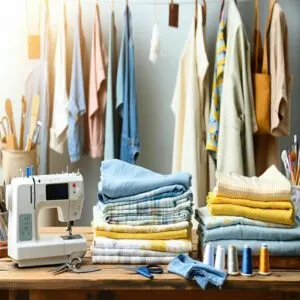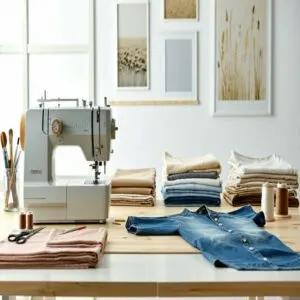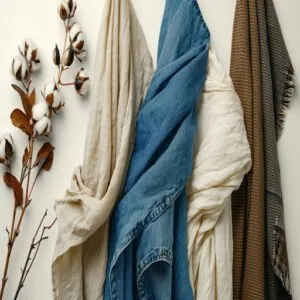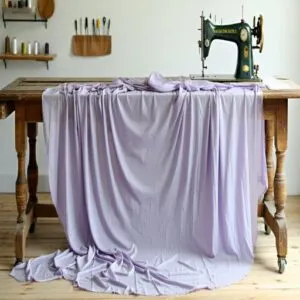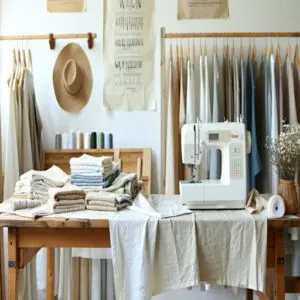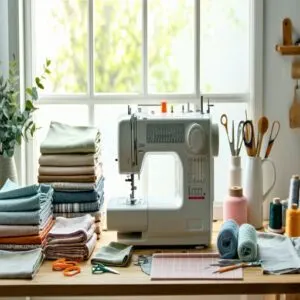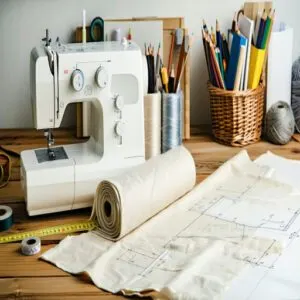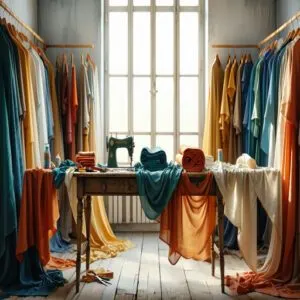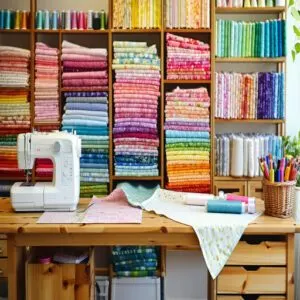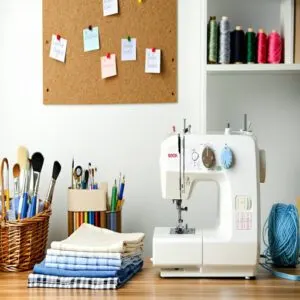This site is supported by our readers. We may earn a commission, at no cost to you, if you purchase through links.

It’s stable, doesn’t stretch like a trampoline, and cuts like a dream.
Linen, another great option, behaves well under a needle and gives off that effortless “I made this” vibe.
Both have just the right weight, so they won’t bunch or slip away when you’re mid-stitch.
Plus, they’re super forgiving if you make a rookie mistake—who hasn’t?
Starting with these fabrics can boost your sewing confidence and save you the headache of fighting with slippery or stretchy materials.
Ready for the next step? Keep reading!
Table Of Contents
Key Takeaways
- Stick to cotton or linen when starting out—they’re stable, easy to handle, and perfect for building confidence.
- Avoid slippery, stretchy, or overly thick fabrics—they’re frustrating and not beginner-friendly.
- Choose fabrics with minimal stretch and consistent weight for smooth cutting and stitching.
- Match your fabric’s stability and drape to your project design for better results and an easier sewing process.
Easy Fabric Characteristics
When you’re starting out, fabrics that behave themselves make sewing so much easier. Look for ones that don’t stretch, slip, or fray everywhere—your sanity will thank you!
Moderate Weight Fabrics
Moderate weight fabrics are the Goldilocks of sewing—just right for beginners.
Their fabric density and weight distribution keep your projects stable without overwhelming you.
For more options, explore these easy fabrics to sew.
Here’s why they’re must-haves from the easy sewing fabrics list:
- Fabric stability: Woven fabrics won’t bunch or stretch.
- Easy handling: Cutting feels effortless.
- Beginner friendly textiles: Perfect drape, fewer headaches!
Minimal Stretch Fabrics
Picking minimal stretch fabrics is like finding a dance partner that won’t trip you up.
Cotton blends, like sweatshirt fabric or ponte, balance fabric stability and stretch resistance perfectly.
These beginner-friendly textiles stay put and don’t unravel, making them easy to sew fabrics.
Stick with woven fabrics or thicker knits from any easy sewing fabrics list—they’re forgiving and fun.
For more information on working with elastic materials, understanding stretch fabric types is essential for successful sewing projects.
Easy Handling and Cutting
Smooth fabric flow makes cutting a breeze.
Look for beginner-friendly fabrics that hold their shape while slicing—like cotton or linen.
Forgiving fabrics like these don’t shift around much, meaning fewer cutting oopsies!
Pair easy-to-sew fabrics with accurate measuring techniques, and you’re good to go.
Bonus tip: keep your scissors sharp, and don’t blame the dog for uneven edges.
When working with fabrics, understanding cotton fabric types is essential for selecting the right material for your project.
Good Grip and Stability
Ever tried sewing slippery fabric that slides everywhere? Frustrating, right?
For easy-to-sew fabrics with good grip and stability, stick to beginner-friendly fabrics like cotton. They stay put and make sewing precision a breeze.
Look for:
- Stable fabrics that don’t shift around.
- Textures offering better grip control.
- Smooth handling to avoid struggle.
- Forgiving fabrics for mistakes.
- Moderate fabric tension while sewing.
Qualities of Easy Sewing Fabrics
When you’re starting out, picking fabrics with beginner-friendly qualities can make sewing a whole lot easier.
Look for materials that don’t slip around, stretch too much, or drive you crazy trying to cut them, which are often associated with beginner-friendly qualities.
Low Stretch for Stability
You know what makes sewing stress-free?
Easy to sew fabrics that behave.
Woven and cotton fabric, for instance, offer great stability—allowing your stitches to flow without fighting the fabric.
Beginner-friendly textiles with low stretch, like chambray or linen, keep fabric tension control in check.
Stable fabric choices = smooth sewing experience.
No wrestling matches with stretchy chaos needed, as stable fabric ensures a pleasant sewing process.
Smooth or Textured Surfaces
Got your eye on fabrics? Pay attention to how the surface feels—it’s a game changer for sewing ease.
Smooth fabrics like cotton lawn or chambray glide through your machine. Textured surfaces like flannel or ponte knit grip well, making them beginner-friendly fabrics.
Here are must-knows:
- Smooth fabrics = clean lines.
- Textured = reduced slippage.
- Choose balanced weave patterns.
Good Drape and Flow
Think about how fabric moves when you sew—this is where drape and flow shine.
Lightweight upholstery fabric or soft cotton fabric with flowing textures creates gorgeous draping and smooth garment silhouettes.
For beginners, easy fabrics with gentle, soft folding guarantee patterns appear polished without much effort.
It’s like giving your project natural grace and a confident flair.
Consistent Weight and Thickness
A fabric with consistent weight and thickness is like finding the perfect dance partner—balanced and predictable.
It keeps stitches even and avoids those frustrating fabric jams.
Beginner-friendly fabrics like cotton and linen shine here, thanks to their even weave and balanced texture.
Fabric density and thickness control make easy sewing a breeze, boosting your confidence and results.
Understanding the benefits of an easy fabric choice is essential for a stress-free sewing experience.
Benefits of Easy Fabrics
Choosing easy fabrics makes sewing less stressful and more enjoyable, especially when you’re just starting out.
They help you avoid frustrating mistakes, save time, and boost your confidence with every finished project.
Improved Sewing Experience
Choosing easy-to-sew fabrics makes sewing feel like less of a chore and more of a creative escape.
Beginner-friendly fabrics, like cotton and linen, handle smoothly, letting you focus on stitching, not untangling frustrations.
These fabrics build Sewing Confidence quickly, making beginner projects a breeze.
With the right Fabric Selection, your Garment Quality improves, and the experience becomes truly rewarding.
Reduced Financial Risk
Starting with beginner-friendly fabrics like cotton or linen isn’t just smart—it’s kind to your wallet.
These affordable materials mean fewer mistakes burn through your sewing budget.
Easy sewing fabrics are forgiving, so you won’t waste money on botched projects.
Budget-friendly fabrics also cushion financial risks, leaving you free to focus on mastering skills without sweating costly setbacks.
Higher Quality Finished Garments
Choosing beginner-friendly fabrics pays off with polished results.
Easy to sew fabrics, like cotton or linen, don’t fight you during sewing, making seams neat and straight.
This fabric selection guarantees consistent garment durability without frustration.
Plus, precision in stitching and finish techniques feels natural.
When fabric choices are forgiving, the final product looks professional—hello, quality control!
Increased Sewing Confidence
Feeling proud of your work builds confidence fast.
Easy fabrics help you nail beginner projects without the drama.
No slipping, stretching, or puckering—just steady progress.
Here’s why these fabrics are total confidence boosters:
- Fewer mistakes mean happier sewing sessions.
- Smooth handling makes skill building a breeze.
- Quick progress keeps motivation high.
- Flawless finishes showcase your growing fabric mastery.
Working with easy fabric options is essential for a better sewing experience.
Choosing Easy Fabrics
Choosing the right fabric is like picking a partner for a dance—it needs to move with you, not work against you.
Stick to fabrics that are simple to handle, and you’ll save yourself a lot of frustration (and maybe a few choice words) by making a choice that is easy to handle.
Avoiding Challenging Fabrics
Let’s skip the sewing heartbreak, shall we?
Fabric selection tips are your safety net.
Avoid slippery nightmares like silk or sheer fabrics that reveal every goof.
Thick denim or stretchy knits?
Total beginner fabric traps that’ll test your patience.
Start with beginner-friendly fabrics like cotton or linen to dodge sewing project failures and keep things stress-free.
Considering Fabric Drape and Feel
A fabric might’ve the perfect design, but if it doesn’t move or feel right, it’s trouble.
Drape analysis helps you spot fabric flow for sewing ease and garment movement.
Look for natural fibers or textures with these textile characteristics:
- Soft but structured feel
- Lightweight, not flimsy
- Smooth surface
- Balanced stretch
- Consistent thickness
When choosing fabrics, understanding soft fabric types is essential for achieving the desired drape and feel in your sewing projects.
Matching Fabric to Project Design
Matching fabric to project design is like pairing the perfect toppings on pizza—it just makes sense.
Choose beginner-friendly fabrics like cotton or linen for easy sewing projects.
Think about the drape and flow; lightweight textiles work best for skirts, while sturdier options fit jackets.
Sewing patterns play a role too—simple designs love easy fabrics!
Understanding fabric properties is essential for selecting the right material for your project design.
Checking Fabric Care Instructions
Before you grab scissors, check fabric care instructions to dodge surprises like fabric shrinkage or color bleeding.
Peek at care labels to confirm washing, drying, and ironing tips match your lifestyle.
- Washing methods: Is it hand-wash only?
- Drying techniques: Air-dry or tumble-dry?
- Ironing tips: Easy to press or stubborn creases?
- Fabric shrinkage: Pre-wash to avoid heartbreak.
Frequently Asked Questions (FAQs)
Are clothes easy to sew?
Sewing clothes is a bit like riding a bike—tricky at first, but easier with practice.
Simple patterns, easy fabrics, and patience make it doable.
Start small, stick to basics, and you’ll crush it!
What is a good fabric to sew with?
Start with cotton—it’s the sewing world’s best friend.
It’s sturdy, doesn’t stretch much, and won’t fight you while cutting or stitching.
Perfect for beginners, it makes learning feel like less of a wrestling match.
What is a good fabric for a beginner sewing project?
You can’t go wrong with cotton—it’s like the training wheels of fabric.
It’s affordable, stable, and doesn’t slip around, making it perfect for beginners learning the ropes without constant frustration or wasted materials.
What is the easiest stretch fabric to sew?
If you’re diving into stretchy fabrics, go for ponte knit.
It’s stable, doesn’t roll, and sews like a dream.
Beginners love it because it’s forgiving and won’t have you pulling your hair out!
Can a beginner sew with any fabric?
You can sew with any fabric, but starting with beginner-friendly options like cotton or linen makes life easier.
Tough fabrics like silk or stretchy knits can frustrate you fast—save those for when you’ve leveled up!
What are easy sewing projects?
Why wrestle with tricky patterns?
Try sewing a tote bag, pillowcase, or elastic-waist skirt.
They’re simple, forgiving, and fun starter projects that’ll build your skills without making you rip out seams—or your hair!
What is the easiest fabric to sew?
Cotton is hands-down your best bet—it’s stable, doesn’t stretch, and behaves like a dream under your sewing machine.
Plus, it forgives rookie mistakes like crooked stitches, making it perfect for building confidence.
What is the easiest piece of clothing to sew?
A simple woven T-shirt is the way to go.
It’s a no-drama project with straight seams and minimal cutting.
You’ll finish it fast, feel accomplished, and have something comfy to show off right away.
What is the best fabric for basics?
You can’t go wrong with cotton for basics—it’s sturdy, affordable, and an absolute breeze to sew.
It’s like the best friend of fabrics: dependable, forgiving, and always ready for any beginner-friendly project.
What type of fabric is commonly used by beginners?
Think of cotton as your training wheels—it’s steady, forgiving, and handles mistakes like a champ.
From lightweight cotton lawn to sturdy denim, it’s the go-to for beginners chasing their first successful sewing project.
Conclusion
Imagine this: You’ve just sewn your first tote bag with cotton, and it turned out amazing—no tangles, no stretch disasters.
Starting with an easy fabric to sew, like cotton or linen, can make all the difference when you’re learning.
These fabrics help you avoid frustration, build skill, and create pieces you’ll actually be proud of.
So skip the slippery satins (for now) and stick with forgiving options that feel more like your sewing BFF than an unruly challenge.
- https://www.polkadotchair.com/50-fun-beginner-sewing-projects/
- https://www.moodfabrics.com/blog/ideal-fabrics-for-beginner-sewists/
- https://so-sew-easy.com/fabrics-for-beginners/
- https://www.blackbirdfabrics.com/en-us/blogs/resources/the-five-best-fabrics-for-beginners-start-learning-with-these-easy-to-sew-fabrics
- https://www.hartsfabric.com/

